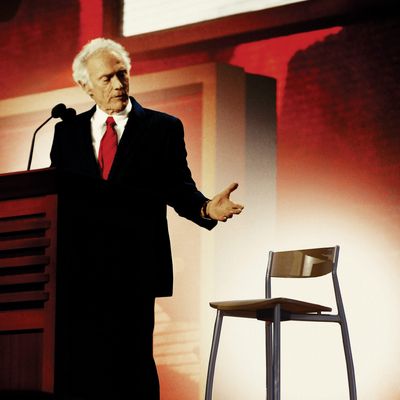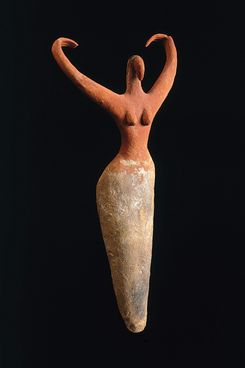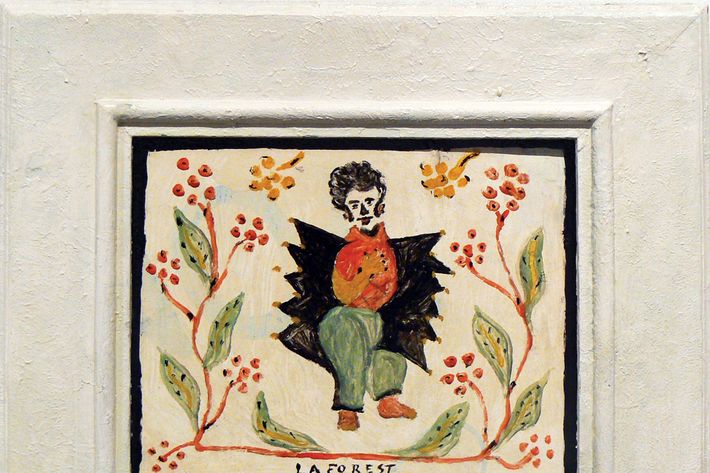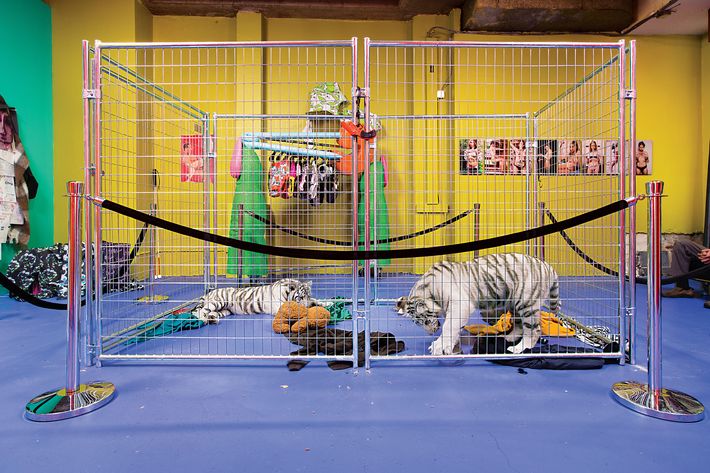
1. Clint and the Chair
A new genre of performance artÔÇöcall it ÔÇ£Neo-VerityÔÇØÔÇöbecame shockingly vivid and visible in front of tens of millions this year. The first manifestation appeared the evening of August 30, when Clint Eastwood staged his infamous empty-chair performance at the Republican National Convention. Instead of playing out a highly scripted, rehearsed scene of political pseudo-reality, Eastwood seemed to split reality in two onstage: As Republican stalwarts willed themselves to see an American icon elevating irony to new heights and sticking it to the president, everyone else saw a party marooned in a self-replicating, self-fortifying private reality.
That distinction exploded wide at around 10:30 p.m. on November 6. In one of the most unforgettable political performances of all time, Karl Rove tried to create his own topography of truth while annulling mathematical fact in actual time. Neo-Verity was established.
Robert Rauschenberg famously said he wanted to work in the ÔÇ£gap between art and life.ÔÇØ Rove and Eastwood mark the disappearance of that gap. Life became art, fictionalized truth and made-up narrative transmuted into form. As with real art, time expanded, slowed down; viewers became aware of complex interplays between realities; logic was bypassed, multiple patterns of meaning formed. Unlike art, however, this live-performance genre lacks the flexibility gene. It is unable to sustain any reading of itself except the one intended; it cannot tolerate paradox. This, oddly, is one reason it can exist only in real time. (Also interesting: ItÔÇÖs critic-proof. No commentary can keep up.)
IÔÇÖve seen Neo-Verity in more conventional art settings as well. For exampleÔÇöand though it didnÔÇÖt contain the same degree of public meltdown or disconnection with realityÔÇöBjarne MelgaardÔÇÖs placing two live tiger cubs in his gallery show at Ramiken Crucible let reality come crashing through, throwing animal-lovers into hysterics. Was this an act? Spectacle for its own sake? Or something so real it shocked? The faux meth labs and sculptural tableaux by Jonah Freedman and Justin Lowe are almost real in their absolute fakeness. In her street performances, Sharon Hayes reads love letters and political statements to passersby who never know whether what sheÔÇÖs doing is real or feigned. Neo-Verity might be the performance equivalent of the visible money shot in porn: something real and unreal at the same time.
2. ÔÇ£The Dawn of Egyptian Art,ÔÇØ at the Metropolitan Museum of Art
This show zeroed in on the Predynastic and early Dynastic Nile Valley, when the Neolithic mind turned modern and found an utter clarity.

3. Klara Liden, at Reena Spaulings
Liden packed a gallery with found, dying Christmas trees and a couch on which to reflect. The work equaled Richard SerraÔÇÖs in physicality, disequilibrium, and room-filling power.
4. ÔÇ£Haitian Masters,ÔÇØ at Edward Thorp Gallery
For his shows of masterworks by Haitian depicters of Edenic beauty and nightmarish colonialism, this gallerist deserves a MacArthur. 

5. Marie Lorenz, at Jack Hanley
This artist-pirate-mutineer is known for videos of her sailboat forays around New York Harbor, as she arrives on tiny secret islands, giving tours of strange settings.
6. ÔÇ£Joanna Malinowska: Fieldwork,ÔÇØ at the Whitney
At the Biennial, Malinowska channeled enormous power, staging a concert of the Moonlight Sonata on toy pianos and getting 100 onlookers to howl at the tops of their lungs. 

7. Bjarne Melgaard, at Ramiken Crucible
Melgaard followed up a triumphant 2011 group show with a fantastic array of outsider and insider artists, as well as those caged tigers. Jaws dropped. Insight ensued.
8. Andra Ursuta, at Ramiken Crucible
For her second solo show, Ursuta showed herself a master of materials, craft, form, political commentary, recent history, magical insight, and sculptural powerÔÇöand smashed the galleryÔÇÖs window.┬á┬á
9. Kerstin Br├ñtsch, at Gavin BrownÔÇÖs Enterprise
For her first New York solo, this artist installed intricate glass-and-steel display grids around the gallery. Viewers felt the presence of a master of materials and space.
10. EAI and DiaÔÇÖs tribute to Mike Kelley
All day on April 14, on my gallery rounds, I kept going back to this twelve-hour, one-day-only video tribute. Each time I was staggered anew at KelleyÔÇÖs imaginative power and the loss his death brings.
Plus:
The Good:
Rembrandt, ÔÇÿPortrait of the ArtistÔÇÖ
Metropolitan Museum of Art/Kenwood House: The height of Western self-portraiture, everyday life, and what it means to be an artist facing a canvas.
The new Barnes Foundation
Like it or hate itÔÇöand I love itÔÇöthis collection looks better than it ever has. Forget the ownerÔÇÖs wishes. Honor the art.
Keltie Ferris
Mitchell-Innes & Nash: FerrisÔÇÖs kickass electric abstract magic-carpet paintings are alive with color and bursting with nerve.
ÔÇ£Free as Air and WaterÔÇØ
Cooper Union : Bravo to the graduating Cooper Union students who decided to give their B.F.A. work away to visitors for free.
Jackie Saccoccio
Eleven Rivington : Vivid abstractions of wobbling, hallucinogenic force and beauty.
The Bad:
ÔÇ£Regarding WarholÔÇØ, The Metropolitan Museum of Art: The Met gets five millennia of art perfect. ItÔÇÖd better stop sucking at the second half of the twentieth century.
Click Here to See More From the Year in Culture 2012
*This article originally appeared in the December 10, 2012 issue of New York Magazine.

